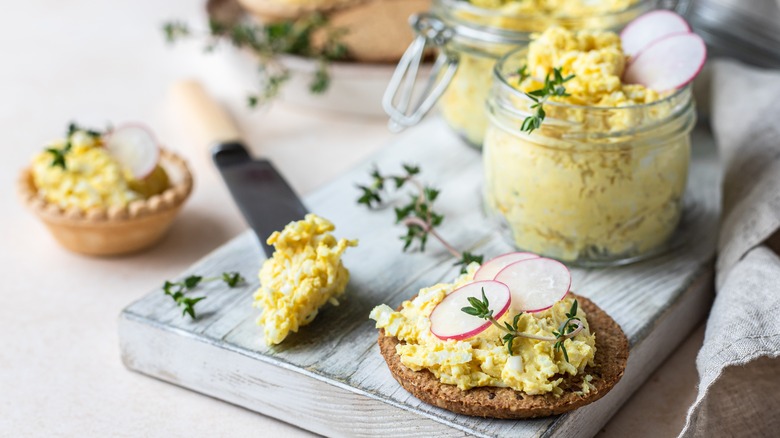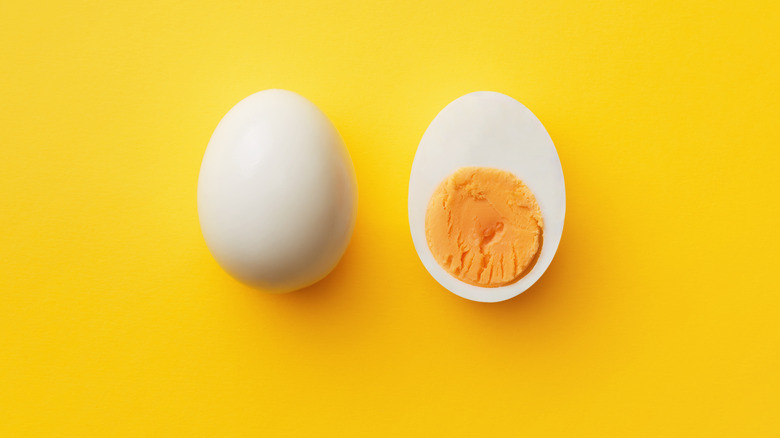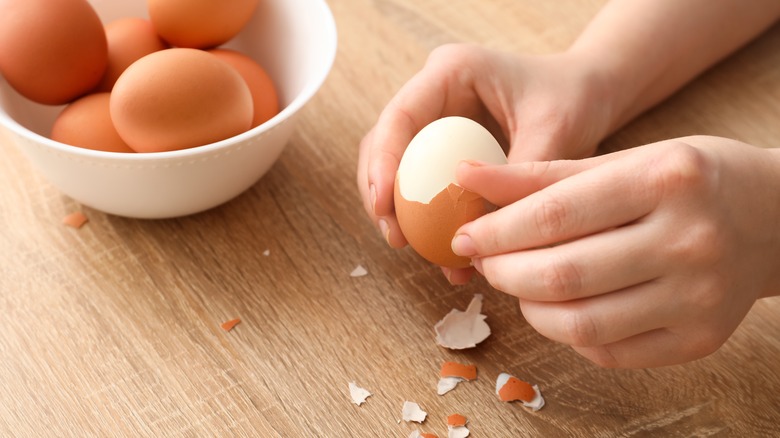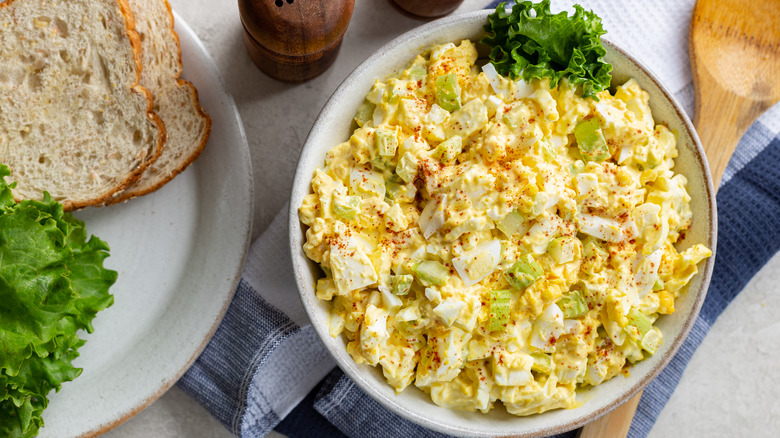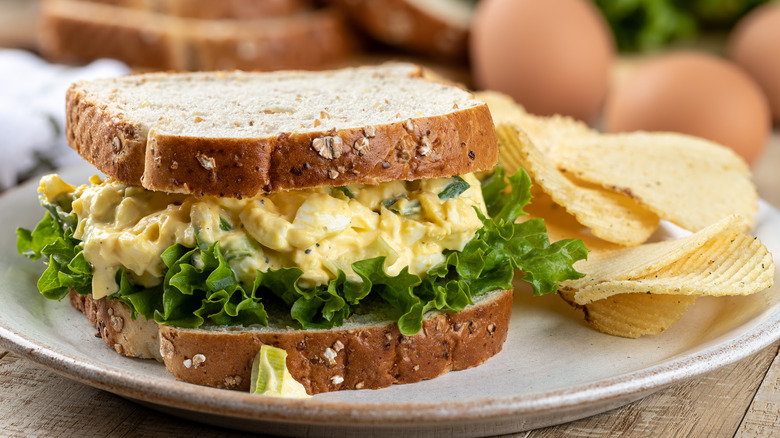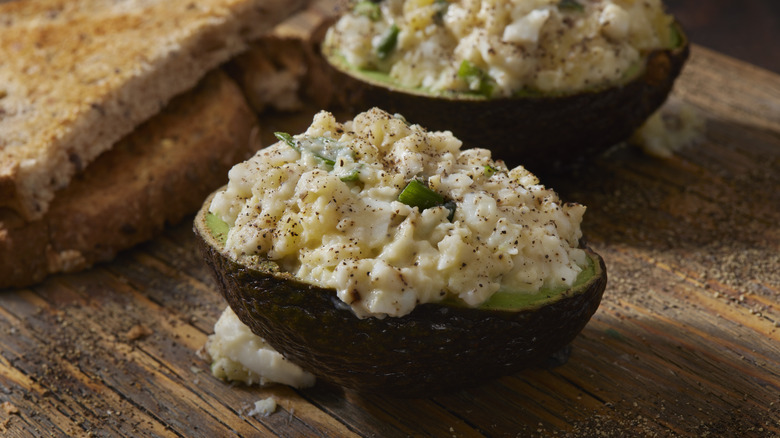The 5 Mistakes You're Making With Egg Salad
An American summer barbecue or picnic just wouldn't be the same without a classic egg salad. But forms of this dish are also popular around the world, with unique international egg salads enjoyed in countries like Poland, South Africa, Thailand, Ukraine, and Morocco. Most of these salads start with boiled eggs; and while the ingredients and dressings can be quite different, some of them, like pasta jajeczna (Polish egg salad), are quite similar to the American version we love with hard-boiled eggs, mayonnaise, and mustard.
While egg salad is a delicious meal when made correctly, there are a few common mistakes people make that result in an unappealing texture or appearance. Cooking and peeling the hard-boiled eggs themselves can be a tricky process if you're not familiar with the method. No one wants to serve their guests egg salad with either runny and raw or tough and overcooked eggs, not to mention egg whites pockmarked from eggshells that were impossible to remove cleanly. Other easy-to-make errors result in a soggy egg salad that looks like a mushy yellow paste. Luckily, we've learned how to solve these problems. Read on to discover how to avoid five common egg salad mistakes, and prepare a delicious dish that will ensure you're invited back to those summer barbecues.
Improperly cooking hard-boiled eggs
Overcooking or undercooking hard-boiled eggs is a mistake that can affect the results of your whole egg salad. The trick is to get fully cooked eggs with tender whites and creamy yolks. Cooking them too much causes the whites to get rubbery and the yolks to be greenish, overly dry, and crumbly. The whites cook rather quickly, but it takes time for the yolks to catch up, so not cooking them long enough produces soft-boiled eggs with runny yolks that won't hold together in the salad.
To avoid either of these scenarios, follow this method for cooking perfect hard-boiled eggs: Place the cold eggs in an appropriately sized saucepan and fill the pan with cold water until it just covers the eggs. Bring the water to a boil and wait 30 seconds. Then, immediately remove the pan from the heat, cover it, and let it sit. The number of minutes you let the eggs sit in the hot water depends on the size of the eggs. Medium eggs will cook in 9 to 10 minutes, large eggs in 11 to 12, and jumbo eggs in 13 to 14 minutes. We recommend large eggs for egg salad because the greater proportion of whites to yolks makes the whites more noticeable in the finished dish. When the time is up, immediately transfer the eggs to an ice bath until they're cool. This stops them from cooking further.
Not peeling the eggs correctly
It's no fun when the eggshells stick to the eggs and take chunks of egg white with them. Peeled eggs that are full of craters affect the appearance of egg salad. Luckily, following some hard-boiled egg tips can take the guesswork out of making eggs you can actually peel.
While normally the freshest food is best, it's a mistake to use new eggs because they will be harder to peel. It's best to peel them if they're one to two weeks old because the egg whites will have had time to dry out a little. The egg whites release moisture through the pores in the eggshell and shrink slightly in size when boiled. In older eggs, the smaller whites aren't positioned as close to the shell, which makes them easier to peel.
Another mistake is not adding a little vinegar or vegetable oil to the cooking water to help with the peeling process. Vinegar helps break down the porous eggshell as it cooks, while oil enters the shell and forms a layer between the egg white and the eggshell, making the shells easier to remove. Also, don't skip the ice bath. It not only stops the cooking, but the quick cooling makes the eggs easier to peel, too. You can even crack them a little during this step — cold water will enter through the cracks to make the cooling process more effective.
Overworking your egg salad mixture
Not leaving enough texture in your egg salad, or failing to retain noticeable pieces of egg whites that don't blend in with the yolks and the dressing, will result in an unappealing dish that looks like a homogeneous yellow mush. You can avoid this mistake by not overworking your egg salad mixture. An easy way to do this is by not using a fork to mash the hard-boiled eggs because fork-mashing breaks the whites into tiny pieces and causes the yolks to turn everything yellow. You can keep the texture by chopping the eggs into medium or large pieces with a knife. An egg slicer or a potato masher are other tools that would work, and could even save you a few minutes of prep time.
In the same vein, after you mix the dressing, don't add the chopped eggs and other ingredients and proceed to mix everything together vigorously. This is another way to remove the texture and make your egg salad pasty. Instead, mix the added ingredients into the dressing, then gently fold in the eggs until they're just coated.
It's worth noting that overmixing isn't necessarily a mistake since some recipes call for it, such as Tamago Sando, a very creamy Japanese egg salad that's actually made in a blender. But if you're a fan of textured egg salad with discernible pieces of whites and yolks, keep the fork in the drawer.
Making soggy egg salad
There are a few common reasons why your egg salad mixture might end up soggy and wet. The first reason is that you're using less than full-fat mayonnaise. Lower-fat versions are moister, and so is Miracle Whip (which many people don't realize isn't actually mayonnaise). For best results, stick to full-fat mayonnaise instead.
The second reason could occur if you've let your egg salad sit out too long. The salt in the dressing will draw moisture out of the more watery ingredients, like onions and vegetables, as the salad sits. It's best to eat it fresh. You should also try to avoid vegetables with a high water content, like cucumber, celery, and bell pepper. Finally, don't add warm eggs to your egg salad mixture. Make sure you've cooled the eggs completely before peeling them and mixing them with the other ingredients to avoid a watery egg salad.
Once you've decided on the best bread for egg salad sandwiches, consider this tip to keep your whole sandwich from getting soggy: Either toast the bread first to dry it out or place a barrier between the egg salad and the bread. Lettuce leaves, or a thin layer of an oily ingredient like mayonnaise, do the job well.
Not using the right ingredients
Egg salad really doesn't need a long list of fancy ingredients. A simple version only requires eggs, mayonnaise, mustard, salt, pepper, and an acid, such as apple cider vinegar or lemon juice. Don't be afraid to go beyond yellow mustard. We recommend Dijon, but spicy brown or dried ground mustard also works. The acid will add flavor and tang. We also like to add alliums like chives, scallions, onions, or shallots, and a fresh (not dried) herb like parsley, dill, tarragon, basil, or thyme.
If you want to upgrade your egg salad with additional flavors, consider using Worcestershire sauce, dill or sweet pickle relish, or spices like paprika, cumin, or curry powder. Spice lovers can add hot sauce or sriracha for a touch of heat. Crunchy vegetables like carrots, celery, or radish can elevate the texture, but you should avoid distraction in your egg salad by sticking to a maximum of two crunchy ingredients and omitting overly large pieces.
When choosing additional ingredients, don't go overboard. Pick a few that go together to keep the focus on the eggs. A classic egg salad wouldn't be the same without full-fat mayonnaise, but make sure you don't use too much. If you want to lighten up the dish, you can use a lower-fat version or replace part of the mayonnaise with sour cream or Greek yogurt. This will change the flavor a little, but your egg salad will still taste delicious.
